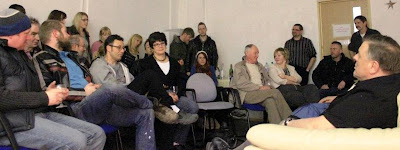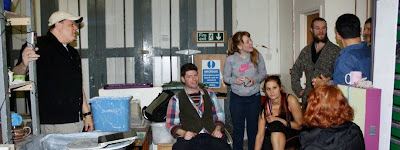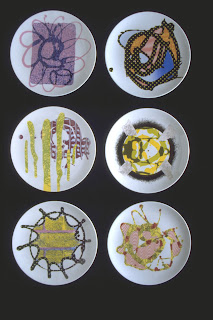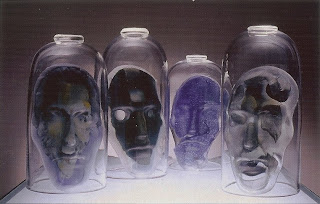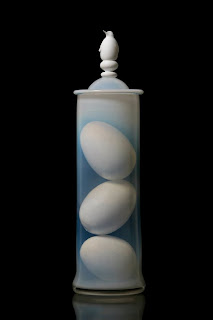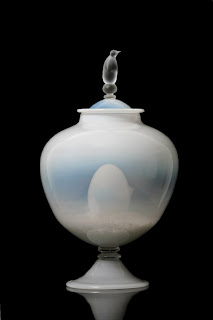>
| Queen Victoria strolls thru the grounds of the Washington Glass School and Flux Studios. |
The British Are Coming!
US/UK exhibit of glass and ceramics, March 1 – 23, in Washington, DC.
Using an art exhibition as a bridge between two countries, the Sister City program will be bringing together Sunderland, England and Washington, DC in a show that celebrates the medias of glass and clay, as well as celebrating the relationships between the two cities.
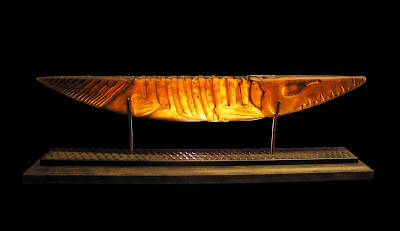 |
| USA / Syl Mathis / Glass |
Opening March 1, 2013, at Washington, DC’s Edison Place Gallery will be an exhibit of expressive glass and ceramic artwork, as well as narrative sculptures that blend craft materials with digital technologies and, in turn remove the boundaries between the traditional categories of craft, art, and design.
 |
| USA / Novie Trump / Ceramic |
Artists and artwork will soon be arriving from the UK’s Creative Cohesion and University of Sunderland, and DC – based artists represented by the Washington Glass School and Flux Studios will be acting as “cultural ambassadors” facilitating the exchange of ideas and images. In addition to a spectacular exhibit, a number of demos and workshops are planned during the month at the gallery and the DC area studios.
 |
| UK / Roger Tye / Glass |
This will be the third collaboration with DC’s Sister City of Sunderland – in 2008 “Glass 3” was held in Georgetown; in 2009, 38 artists from Sunderland participated in the 10th Artomatic, held near the Navy Yard.
Washington Glass School’s Fulbright Scholars Michael Janis and Tim Tate taught at both the University of Sunderland and at Creative Cohesion studios during their Fulbright assignment in 2012, and look forward to renewing the close relationship created by these collaborations.
 |
| US Fulbrighters Janis & Tate 2012 workshop at Creative Cohesion studios in Sunderland, England |
The International Glass + Clay show opens March 1st and will run through Friday, March 23, The exhibit is free and open to the public. The Gallery Place Metro station is within walking distance of the Gallery.
The Downtown Business Improvement District (Downtown BID), in partnership with Artomatic, Inc., the Office of the Secretary for the District of Columbia, and Sunderland City Council, have together organized the international exhibit, hosted at Pepco’s Edison Gallery.
International Glass and Clay 2013
Edison Place Gallery
702 Eighth Street (between G & H Streets)
Washington, DC
Emotional Leak
>
Dickson/Sarmeinto, Emotional Leak, 2011: waterjet cut glass with steel and rubber base about 9.5 x 4 x 4 ft 
Below is a video of the construction of Emotional Leak –
Recruiting for PhD in Glass and Ceramics
>
| Prof Petrie outlines the benefits of advanced degrees in the arts offered by the University of Sunderland. |
Kevin Petrie, Leader of the UK University of Sunderland’s Glass & Ceramics program is in the US this week for the Toledo GAS Conference, popped into the Glass School for a quick visit. Kevin met with Washington Glass School instructors and artists, talking about the UK’s “Distance Education program”. Kevin’s mission from the University is to get more PhD glass artists out there, and he will be talking at the Conference’s Tech Booth #17.
| Erwin Timmers talks of sustainable design in glass to Prof Petrie. |
| Erwin talks of his process to create his colorful forms. |
PhD In Glass at University of Sunderland
>Kevin Petrie, professor of Glass and Ceramics at the UK’s University of Sunderland will be coming to the Glass Art Society’s (GAS) Conference at Toledo to talk with people interested in studies in glass at the University.
The
| The University of Sunderland Glass Facility |
The
From the
Students will be taught by international award-winning staff, who are all recognized professional artists, designers, curators and writers. You will also be offered real-world opportunities, including the chance to show your work in public exhibitions, undertake internships, work on live commissions, and enter competitions – all of which will help you to build your career.
We are a supportive creative community and encourage our students to become nationally, and internationally, networked during their time on the course. Our students have been selected for distinguished exhibitions such as the British Glass Biennale, Bombay Sapphire Glass Prize and the European Glass Context. Many of our graduates become independent artists with their own studios. Others are successful educators. A substantial number of our students are professionals who undertake doctorates to reflect on their work, advance creative practice and contribute to knowledge in the field of glass art.
UK Hosts 2nd International Symposium of Architectural Glass
>
The UK International Institute of Research in Glass (IIRG) presents the 2nd International Symposium in Architectural Glass, focusing on ‘Working with light as a means of interaction between space and the mind’.
The emphasis of this event is on how flat glass is used three dimensionally in space and as a creative means of expression. This will explore both the theoretical and practical aspects of this process: idea exploration; design development; use of new technologies; the possibilities of technical restrictions; and the multi-disciplinary approach prevalent in many projects.
The Symposium will run on Thurs/Friday, May 17 &18, 2012 at the National Glass Centre in Sunderland, England. The event will take the form of traditional lectures, panel discussions, workshops demonstrations and informal networking opportunities. Speakers include:
Marian Karel
Dana Zamecnikova
Judith Schaechter
Algirdas Dovydenas
Daan Roosegaarde
Rodney Bender
Tim Macfarlane
Alexander Beleschenko
Early bird fees, if you book and pay before the 1 May:
One day £55, Two days £90
You can book your place through the University online shop, just search Conference/Events International Glass Symposium.
http://onlinestore.sunderland.ac.uk
University of Sunderland, National Glass Centre
Liberty Way
Sunderland, UK, SR6 0GL
Fulbright Scholars Janis & Tate Final Report
>Final Report by Michael Janis and Tim Tate regarding their Fulbright Specialist Program at the University Of Sunderland and the National Glass Center.
The bonds that were forged years ago when The City of Washington & Washington Glass School hosted the UK artists from Cohesion Glass Network art Artomatic’s Glass 3 event in Georgetown have been strengthened. Our connection with Washington, DC’s UK Sister City, Sunderland, the National Glass Center and the University of Sunderland; will continue throughout our careers. While our mission as Fulbright Scholars was to impart information, we leave having learned many lessons.
Our time in England began with presentations of our artwork and discussions of on new directions the glass world was embracing, such as Glass Secessionism, where artists are looking to move from the aesthetic of pure technique, materials and process and are advancing glass as a medium of sculptural expression in the narrative realm. The participants in the audiences came from the student body of the University as well as working artists from Sunderland, Newcastle, even as far away as Edinburgh, Scotland. The audience stayed long after the talk, and topics from the discussion continued to come up during our entire Fulbright program stay (and indeed, afterwards via the internet) showing the strong relevance of the concepts.
We created workshops for both the National Glass Center and Sunderland’s Creative Cohesion studio; the city’s artist incubator (that, in fact, used the Washington Glass School as its educational and business model). The City of Sunderland invited us to speak with students at a local secondary school during our stay, where we talked about careers in art. We also worked with the Leaders of the University’s Glass and Ceramics program and outlined methods we could extend the cooperative agreement that exists between Sunderland and Washington, DC.
The British tertiary arts education system is different from the US university model. Their MA program blends an MFA and BFA into a very concentrated program. The amount of expertise, materials and techniques they make available to students seems staggering. Sunderland’s may be the finest glass program in the world. With the National Glass Center, the physical space alone dwarfs any facility in the US (or even if one combined the arts centers of Pilchuck, Penland, Corning into one place). The University of Sunderland also offer a doctorate in glass, which is similar to an MFA, though the focus is research, as this is one of the primary methods for the University to receive funds. At the end of a student’s time at Sunderland University, they have a much broader base of knowledge regarding glass and its parameters. In many ways the educational system in the UK is ahead of the US, especially in how they treat glass sculpturally.
Our talks with the students included observations on the differences between the art practices of the two countries. The gallery/collector focus on technique driven vessels that drove the US Studio Glass Movement for over 40 years did not occur to the same extent in England. Instead of being gallery driven, the UK arts education sector seems to be more exhibition and grant driven. University and museum -sponsored art shows are more common as the way an artist would establish themselves. With this as their foundation, artists do not find it as necessary to focus on a single form. They are able operate with the freedom of each installation being potentially a different medium, voice, direction (though many times I would have liked to see the directions pushed much further.) In the US, with the galleries / collector based system, there exists the perception that an artist’s work be recognized for a particular form and for the work be within a series format.
The courses we held at the University included a mix of graduate and undergraduate students, and the workshops allowed and encouraged students working in different modules to interact. We found the students of the University to be some of the most engaged and accomplished students we have ever worked with. They wanted to absorb as much information as possible. Their energy was refreshing, and we added another workshop and added one talk more into the schedule.
Our final discussion was on Artist Covenant’s and how artists can create a network using social media as a way to support each other as a group. This informal talk was packed, standing room only. The artists were voracious in seeking advice on how to get their work seen and recognized. We hope we have helped energize them and perhaps rally them to work together towards their common good. The interest and respect we received from the students was over-whelming. Many of the artists have connected to us online.
We would like to thank all those who made this academic interaction possible: The Fulbright Commission, the Council for International Exchange of Scholars (CIES), The University of Sunderland and the National Glass Center, The City of Sunderland and Creative Cohesion. Each in their own way has made our visit into a life changing experience.
Our mission is to now to reflect and contemplate on not only what we have achieved, but to think of ways on how best to extend our hand and continue our symbiotic and synergistic relationship so that it will not only survive but thrive.
Lets all bridge the Atlantic for many more decades.
Tim Tate & Michael Janis , Co-Directors, Washington Glass School
Fulbright Scholars at University of Sunderland
>
Our Fulbright schedule began to fill the days.The first workshop we held at the University of Sunderland’s National Glass Center: “Affecting Sheet Glass – Bas-Relief Imagery in Glass” was filled. The technique of “dry plaster casing” was outlined, and firing schedules were converted from Fahrenheit to Celsius – along with converting all dimensions from imperial to metric. (Why did the US decide to not join the world in the 70’s when we were supposed to go all metricationed?)
Tim Betterton sets up the kilns for dry plaster casting.
After the firing, its like Christmas day as the students eagerly retrieve their kilnformed glass sculptures.
We were able to meet a number of incredibly talented artists that were associated with the University and their work was so strong that we will post some of the work and profiles about the artists in each of the next few blog updates:
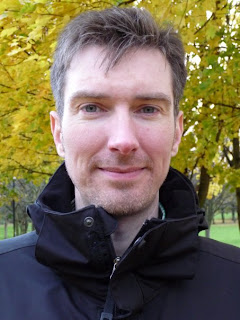
Dr Kevin Petrie leads the Glass and Ceramics department at the University of Sunderland. Kevin studied Illustration at the University of Westminster and Ceramics and Glass at the Royal College of Art. He holds a PhD in ceramics and print from University of the West of England, Bristol. Kevin’s first book ‘Glass and Print’ established the crossovers between Glassmaking and Printmaking. The book forms the cornerstone of a period of research that established the cross over between two largely separate strands of creative activity. His second book, ‘Ceramic Transfer Printing’ draws together the great potential of print for ceramics. Kevin has written many articles and reviews for journals such as Ceramic Review and presented his work on glass, ceramics and print in Canada, Thailand, Hong Kong, Denmark, Germany, USA, Australia, and China. He was recently awarded a National Teaching Fellowship for his contribution to glass and ceramics teaching, in particular this relates to postgraduate at MA, MPhil and Ph.D levels.
Dr Petrie’s work often refers to the long tradition of graphic ceramic surface decoration at the same time as reflecting contemporary life.
St Pauls Church, kilnformed glass
Cell of Himself, Kiln form glass with printed inclusions, blown glass
Besides his own work as an artist, Dr Petrie is an author, lecturer, exhibition curator, and he is an authority and specialist on contemporary glass and ceramics matters. He has lectured at the following institutions: The University of the West of England, Bristol, The University of Westminster, London, Norwich School of Art and Design, Bath Central St. Martins School of Art and Design, London, Rajabhat Institute Changmai, Thailand, Australia National University, Canberra, Australia, Monash University, Melbourne, Australia, Sydney College of the Arts, Australia, Anla Glas, Denmark, Hong Kong Baptist University – Academy of Visual Arts.
__________________________________________________________

If you are familiar with the first of the DC / Sunderland glass exhibition “Glass3” that was held in Georgetown in 2008, you might have seen James Maskrey‘s work. His work has really transformed into haunting and ethereal work. Social situations, overheard conversations, observed interactions and personal experiences hugely inspire Jim’s work. Tall stories, elaborate hoaxes and peculiar facts, usually from a bygone era, are then translated into glass, often resulting in flamboyant narratives, theatrical compositions or simple objects with a twist. The series below are from a series based on the polar expeditions by Edward Wilson to collect penguin eggs.
The Worst Journey in the World, blown and hot sculptured glass details, 2011. Photo by David Williams
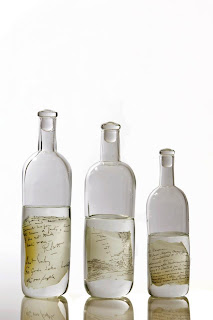

Last Entry,Winter Journey, andThe Barrier, 2011, Blown and solid formed hot glass with printed glass inclusions.
The works poetically and poignantly touches on themes of collecting and hubris. In the austral winter of 1911, Wilson led “The Winter Journey”, a doomed journey to the Emperor penguin’s breeding grounds at Cape Crozier to collect eggs for scientific study. The eggs were supposed to reveal the evolutionary links between dinosaurs and birds but their collection nearly killed the journey’s participants. Frozen and exhausted, they successfully collected three eggs and desperately exhausted they returned to Cape Evans, later describing this expedition “The Worst Journey in the World.”
James started working with glass in 1990. After graduating in 2000 with a Three Dimensional Design BA (Hons) degree in glass at The Surrey Institute of Art and Design he was appointed as Artist in Residence at the Surrey Institute. In 2001 James joined the Glass and Ceramics department at The University of Sunderland and graduated with an MA in Glass with distinction in 2004. Jim was recently named as one of the artists that will exhibit at the British Glass Biennale 2012.
Coming Next – London Affordable Art Fair & Imagery in Glass Class and featured Sunderland Artists: Jeff Sarmiento, Cate Watkinson and more!






